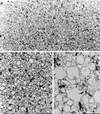ATP-Dependent formation of phosphatidylserine-rich vesicles from the endoplasmic reticulum of leek cells
- PMID: 10318702
- PMCID: PMC59257
- DOI: 10.1104/pp.120.1.245
ATP-Dependent formation of phosphatidylserine-rich vesicles from the endoplasmic reticulum of leek cells
Abstract
Leek (Allium porrum) plasma membrane is enriched in phosphatidylserine (PS) by the vesicular pathway, in a way similar to that already observed in animal cells (B. Sturbois-Balcerzak, D.J. Morre, O. Loreau, J.P. Noel, P. Moreau, C. Cassagne [1995] Plant Physiol Biochem 33: 625-637). In this paper we document the formation of PS-rich small vesicles from leek endoplasmic reticulum (ER) membranes upon addition of ATP and other factors. The omission of ATP or its replacement by ATPgamma-S prevents vesicle formation. These vesicles correspond to small structures (70-80 nm) and their phospholipid composition, characterized by a PS enrichment, is compatible with a role in PS transport. Moreover, the PS enrichment over phosphatidylinositol in the ER-derived vesicles is the first example, to our knowledge, of phospholipid sorting from the ER to ER-derived vesicles in plant cells.
Figures



References
-
- Alb JG, Jr, Kearns MA, Bankaitis VA. Phospholipid metabolism and membrane dynamics. Curr Opin Cell Biol. 1996;8:534–541. - PubMed
-
- Bar-Peled M, Bassham DC, Raikhel NV. Transport of proteins in eukaryotic cells: more questions ahead. Plant Mol Biol. 1996;32:223–249. - PubMed
-
- Baydoun EAH, Brett CT. Distribution of xylosyltransferases and glycuronyltransferase within the Golgi apparatus in etiolated pea (Pisum sativum L.) epicotyls. J Exp Bot. 1997;48:1209–1214.
-
- Bednarek SY, Ravazzola M, Hosobuchi M, Amherdt M, Perrelet A, Schekman R, Orci L. COPI- and COP-II-coated vesicles bud directly from the endoplasmic reticulum in yeast. Cell. 1995;83:1183–1196. - PubMed
LinkOut - more resources
Full Text Sources
Miscellaneous

